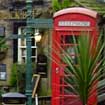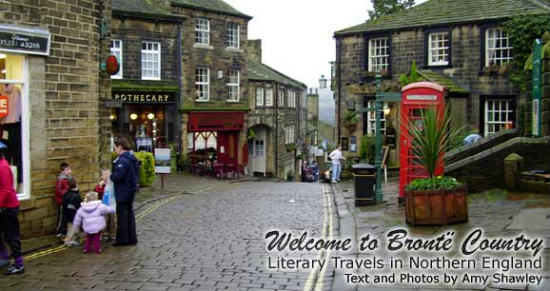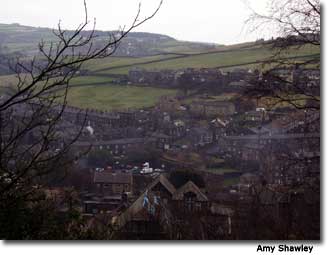

At first glance, the sleepy village of Haworth (population 2,753) in Northern England’s West Yorkshire appears to be nothing more than an ordinary British town. In fact, one may be inclined to pass it by, never noticing the beauty of the town center’s cobblestone streets lined with shops, pubs and restaurants set amid the haunting moors. Haworth was once home to the Brontës — one of the great literary families in the world. It’s a town etched with the history, splendor and charm of a time when three writer sisters penned their works, hailed today as the epitome of Victorian literature.
The Brontë sisters spent most of their lives in the Brontë Parsonage House where their father was a minister. Charlotte, probably the most well-known Brontë, was born in 1816, followed by Emily in 1818, and Ann in 1820. Their mother died shortly after Ann’s birth, and the sisters formed a tight bond, with Charlotte taking on a motherly role. The three girls, along with their brother Branwell, were home-schooled after two elder sisters had fallen ill and died while attending boarding school. The Brontës had few childhood friends, and perhaps this introverted world allowed all four to develop their artistic talents. They created imaginary worlds called Gondal and Andria and wrote stories and poems about them.
As young women in Victorian society, the Brontës had few career options. They took jobs as governesses, which none of them really enjoyed, and longed to be writers. The sisters collaborated on a book of poetry and published it under the male pseudonyms of Currer, Ellis and Acton Bell. They kept these pseudonyms even after their greatest works, their novels, were published, in order to conceal their identities and to be taken seriously not as women writers, but as writers.
Her biographer and friend, Elizabeth Gaskell, describes Charlotte as shy, small and plain, but intelligent and steadfast in her beliefs. Charlotte went beyond Victorian ideals when she wrote Jane Eyre (1847) and proved she could create a heroine who, much like herself, needn’t be beautiful to be interesting. Charlotte and the character of Jane were both independent in nature, rejecting Victorian conventions and financial security by refusing marriage proposals in order to find true love.
Emily, who wrote the classic Wuthering Heights (1847), was tall, strong and reserved rather than shy. She rarely traveled from home and was only happy and well on the moors that surrounded her house. Like her character Heathcliff, Emily refused to adhere to society’s conventions and rules, renouncing religion and interacting only with family.
Ann is described as asthmatic and frail; shy, sweet, and highly religious, her most famous work The Tenant of Wildfell Hall (1848) questions the morality and religious faith of its reader and is considered to be one of the first feminist novels.
All three Brontës lives ended tragically, with only Charlotte reaping the benefits of her great writing. Emily died at home, at age 30, from untreated tuberculosis. Ann acquired the disease from her sister and died within a year at the age of 29. Charlotte managed to find true love and married at the age of 38; however, she died one year later due to complications from an extreme case of morning sickness. During the last years of her life, Charlotte finally revealed her true identity, and that of her sisters, as authors.
Today, the Brontë Parsonage House, which was opened as a museum in 1928, offers a tour of the house with rooms much as they would have appeared during the 19th century. Visitors can see the dining room where the girls wrote their famous works, as well as Charlotte’s room where she died. The church and graveyard sit adjacent to the house with all of the Brontës (except Ann, who died in Scarborough) buried in a family vault beneath the church.

Haworth’s Main Street contains hotels, eateries and souvenir shops named after the Brontës and their works. The Black Bull, a pub frequented by brother Branwell, offers “The Full Brontë” platter for two, featuring a meal of steak, chicken and scampi. Drawings of the Brontës and other historic works of art are displayed. The Villette Coffeehouse sells baked goods, such as Yorkshire pudding and breads.
There are guided tours, which provide history on the Brontës and their lives during Victorian times, and a bookstore containing rare biographies and Brontë novels. Finally, there are walking trails up on the moors leading to the Brontë Falls and Brontë Stone Chair, where the sisters allegedly sat and wrote overlooking the town.
Visitors leave feeling as if they’ve not just seen where the literary sisters once lived, but that they’ve gotten a glimpse into their world as it was. It isn’t difficult to imagine how the village of Haworth, with its majestic moors looming in the distance, inspired them to greatness.
If You Go
Brontë Parsonage Museum and Brontë Society
The museum, located on Church Street, is open every day from 10 a.m. – 5:30 p.m. (April to September) and from 11 a.m. – 5 p.m. (October to March), except
December 24 – 27 and January 2 – 31.
Brontë County
www.bronte-country.com
For biographical information about the Brontës read, The Life of Charlotte Brontë, (1857) by her friend Elizabeth Gaskell (1810-1865).
- Why the Kimberley Should Be Your Next Australian Adventure - July 5, 2025
- How We Finally Afforded Our Dream Trip to the Swiss Alps (And You Can Too) - July 5, 2025
- Escape Manhattan for Governors Island - July 5, 2025
